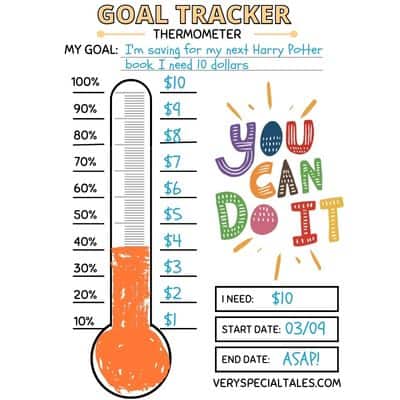
Free Printable Goal Tracker Thermometer for Kids (PDF)
Printable Thermometer Goal Tracker Activity (Printable PDF): In today’s post, we’ll explore why goal trackers help us achieve our objectives. You will also be able to download a fun goal tracker thermometer for kids.
Teaching our kids to set goals goes beyond sharing SMART goal principles.
Once they have a clear goal, certain research-based strategies will optimize their chances of achieving those goals.
One of those essential goal-setting tools is making use of a goal tracker.
Benefits of Setting Goals
Goal-setting helps you identify what you want to accomplish and culminates in a guiding plan that will help you establish how and when you will achieve your goals.
Setting goals allow you to:
- Stay focused on the desired outcomes
- Increase your efforts
- Improve your strategies
- Feel energized
(Source: Locke, Latham, 2002)
In other words, setting goals helps us stay focused on the tasks and activities that will make us succeed while keeping our energy and efforts high.
Goal-setting is not just a tool for “serious adult stuff” like financial goals, weight loss, or family budgeting.
Our kids can benefit from goal setting in many everyday life situations, like:
- habit goals (setting a goal to eat five pieces of fruits or vegetables, or to start wearing deodorant every day)
- learning money-saving skills (learning and saving enough money for a pet fish)
But, ensuring they follow effective goal-setting strategies will improve their chances of achieving their goals.
11 Benefits of Using a Goal Tracker to Achieve your Objectives
“When people discover they are below their goal, they typically increase their effort and/or modify their strategy” (Latham, 2004)
A goal tracker not only captures in one single tool many of the effective goal-setting principles but provides some additional benefits too:
- Written Goals
Writing down your goals works as a written commitment that you make to yourself. Your goal tracker is a representation of that commitment. - Staying focused on your goal
- Tracking progress
- Signals the need to increase effort if you see you are lagging behind your objective
- Identifies any need for strategy changes
- Visually motivating. The visual representation of your goal works as a motivational tool.
- A tool for sharing
Sharing your goals publicly with somebody important to you increases your probability of accomplishing them. - Reward Reminder
Having a reward increases your motivation toward achieving a goal. Often, the target goal is also a reward reminder (for example, when your child is saving to buy a new toy) - Self-confidence Boost. When they use a goal tracker, your children can see just how many times they have completed a task and have worked their way to achieving their goal. When they see the tracker continue to be filled, it can be a self-esteem booster.
- Accountability tool.
When you use a goal tracker to develop a skill, it helps you feel accountable for your actions. - Goal trackers can make boring, repetitive actions more enjoyable.
Goal Tracker Thermometers for Kids
One of my favorite goal trackers is the type that uses a thermometer visual as a guide to represent progress towards a goal.
The use of thermometer goal trackers is widespread.
Examples of simple thermometer charts that you may have found on social media, for fundraising events, or on journal pages are:
- Saving thermometers
- Donations thermometer / Fundraising thermometers
- Crowdfunding campaign thermometers
In the picture below, you can see an example of a thermometer goal chart.![]()
As you can see, it is a great way to represent your child’s specific goal:
- The bottom of the thermometer shape represents starting point (usually zero).
- There is a field where you can input your goal value:
In this example, we can see a savings thermometer, and the kid needs to save $10.
Other examples could be:- a reading goal of 3 books in one month
- a donation target amount of X dollars
- Sometimes it may be useful to establish a specific timeframe. In our example, you can see the start and end date fields.
In other cases, you may be tracking a weekly goal, or you are using a donation thermometer for a fundraising campaign ending on a certain date. - Your child can track their progress by coloring up inside the shape outline until they reach their goal’s current value.
Download your Free Printable Thermometer Goal Tracker for Kids
This fun printable goal tracker thermometer will give your kids an effective way to stay on top of their goals and an incentive to persevere.
Remember to display your child’s printable thermometer goal tracker on your fridge or in their bedroom to keep their personal goals top of mind!
If you are interested in a Google Sheets version, I’ve also created a simple thermometer chart for Excel (link included in your PDF download)
Whether you use it as a fundraising goal tracker, savings tool, or to promote new habits, I hope you enjoy this free printable goal thermometer template.
More Goal-Setting Resources
The following posts will provide you with more goal-setting resources:
- SMART Goals Worksheets
- Goal Setting Activities for Kids
The worksheets in the post linked above include:- A goal ladder to help kids break big goals into smaller goals (or long-term goals into short-term ones)
- A goal planner to help identify obstacles and prepare for them
- Goal Trackers for daily, weekly, and monthly goals (to help break yearly goals into smaller ones)

